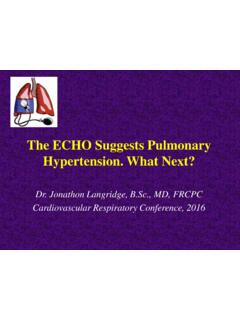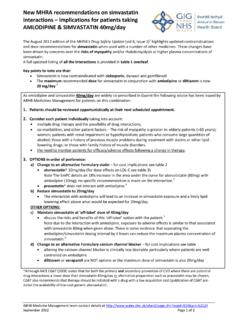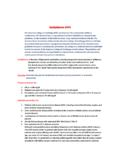Transcription of MANAGEMENT OF THE CARDIAC SURGERY PATIENT AFTER …
1 DISCLOSURE No disclosures, financial, or otherwise to declareANATOMYCARDIOPULMONARY BYPASSCABGVALVE SURGERY Which valve? -Aortic, Mitral, Tricuspid Repair vs Replacement Replacement Mechanical vs Tissue valvePOST-OP RECOVERY CVICU: 1-2 days Monitor for bleeding Wean ventilation\extubate Wean vasopressors, inotropes 3W: 4-5 days BP control HR control, monitor/treat arrhythmias Renal function Pacing wire removal CT removal Mobilization AnticoagulationFIRST POST-OP VISIT TO GP What SURGERY did they have? Were there any in-hospital complications? Vitals including rhythm Volume status hyper vs hypovolemic Wounds Review discharge medications: New meds -duration Discontinued old meds Meds to be titrated Anticoagulation? Target INR? Blood workPOST-OP MEDS ASA Beta-blocker ACE-i/ARB Statin Calcium channel blocker Nitro patch Coumadin Diuretic : SECONDARY PREVENTION2015 Updated AHA Guidelines At risk for subsequent ischemic events as a result of native CAD progression, vein graft atherosclerosis ANTIPLATELET should be administered pre-operatively and within 6 hours AFTER CABG in doses of 81-325mg daily.
2 Should then be continued indefinitely to reduce graft occlusion and adverse CARDIAC events (IA) OPCAB, dual antiplatelet for 1 year with ASA (81-162mg od) and clopidogrel75mg od to reduce graft occlusion (IA) od reasonable alternative AFTER CABG for patients who are intolerant of/allergic to ASA. Reasonable to continue indefinitely. (IIa, C) patients who present with ACS, reasonable to administer ASA and prasugrelor ticagrelor(preferred over clopidogrel) (IIa, B) SMGH 1 yearANTIPLATELET sole antiplatelet AFTER CABG, reasonable to consider higher dose ASA (325mg od) rather than 81mg to prevent ASA resistance, but benefits not well established (IIa, A) + clopidogrelfor 1 year AFTER CABG may be considered in patients without ACS, but benefits not well established (IIb, A)ANTITHROMBOTIC should NOT be routinelyprescribed AFTER CABG for graft patency unless other indications (AF, venous thromboembolism, mechanical valve) (III,A) alternatives (dabigatran, apixaban, rivaroxaban) should NOT be routinely administered early AFTER CABG until additional safety data (III,C)
3 LIPID contraindicated, all CABG patients should receive statin, starting pre-op and restarting AFTER SURGERY (I, A) statin (atorvastatin 40-80mg, rosuvastatin20-40mg) should be administered AFTER CABG to all patients <75 years of age (I, A) statin should be administered AFTER CABG for those who are intolerant of high-intensity statin therapy or at greater risk for drug-drug interactions (I,A) of statin therapy NOT recommended before or AFTER CABG unless adverse reactions (III,B) -BLOCKER CABG patients peri-op -blocker to prevent post-op AF, ideally before SURGERY (I,A) patients with history of MI -blocker unless contraindicated (I,A) patients with LV dysfunction -blocker unless contraindicated (I,B) -blocker (in absence of prior MI or LV dysfunction) may be considered, but other antihypertensivesmay be more effective and more easily tolerated (IIb, B)HYPERTENSION RECOMMENDATIONS1.
4 -blockers ASAP AFTER CABG, in absence of contraindications, to reduce risk of post-op AF and to facilitate BP control early AFTER SURGERY (I,A) CABG patients with recent MI, LV dysfunction, DM, chronickidney disease, with careful consideration of renal function in determining timing of initiation and dose selection (I, B) BP <140/85 mmHg AFTER CABG; however ideal BP target not formally evaluated in CABG PATIENT (IIa, B) to add CCB or diuretic agent as an additional therapeutic choice if BP goal not achieved AFTER CABG despite -blocker /ACE-i(IIa, B)HYPERTENSION absence of prior MI or LV dysfunction, anti-hypertensives other than -blockers should be considered for chronic HTN MANAGEMENT long-term AFTER CABG (IIb, B) ACE-iNOT recommended early AFTER CABG among patients who do not have a history of recent MI, LV dysfunction, DM, CKD because it may lead to more harm than benefit and an unpredictable BP response (III,B)PREVIOUS MI & LV absence of contraindications, -blockers (bisoprolol, carvedilol, SR metoprolol) recommended AFTER CABG in all patients with EF<40%, especially among patients with heart failure or prior MI (I,A)
5 Absence of contraindications, ACE-i/ARBrecommended AFTER CABG in all patients with EF<40% or previous MI (I,B) absence of contraindications, reasonable to addaldosteroneantagonist AFTER CABG for patients with EF<35%who have NYHA II-III (IIa, B) patients with EF<35%, ICD therapy NOT recommended for prevention of sudden CARDIAC death AFTER CABG until 3 months of post-op GDMT and persistent LV dysfunction confirmed (III,A)DIABETES RECOMMENDATIONS Target HbA1c of 7% reasonable AFTER CABG to reduce microvascular diabetic complications and macrovascular cardiovascular disease (IIa, B) Poor glucose control also increases risk of peri-op infectionSMOKING cessation critical, and counseling should be offered to all patients who smoke, during and AFTER hospitalization for CABG, to help improve both short-and long-term clinical outcomes AFTER SURGERY (I, A) to offer NRT, bupropion, vareniclineas adjuncts to counseling for stable CABG patients AFTER hospital discharge (IIa, B) , bupropion, vareniclinemay be considered as adjuncts to counseling during CABG hospitalization but their use should be carefully considered on an individualized basis (IIb, B) CARDIAC REHABILITATION Recommended for ALL patients AFTER CABG, with referral ideally performed early post-operatively during surgical hospital stay (I, A) Important to encourage ongoingphysical activity & CARDIAC dietWhy do they need a nitro-patch?
6 Is he still having angina? Did they forget to discontinue it? What do surgeons know about medications???RADIAL ARTERY SPASM Radial artery -structurally & functionally different from IMA More muscular, more susceptible to vasospasm pharmacologic prophylaxis CCB +/-nitrates most commonly used in OR SMGH practice Nitro patch mg/hrOR Amlodipine Continue for 6 months post-opCASE 1 65 yomale, 1 week AFTER CABGx5 with LIMA, RA, SVG. Feels dizzy whenever he stands up quickly. BP 80/50; HR 55 regular Exam: Wounds healing well, no infection No pedal edema Lungs clear Hgb95, Creatinine 105 Meds: ASA, Metoprolol, Perindopril, Nitro patch , Lasix 40 BID, atorvastatinWhat should you do? Tell the PATIENT to wait until they see the surgeon at 4-6 nitro patch since he is no longer having angina AFTER his ACE-I, beta-blocker, diuretic, and nitro patch.
7 Arrange follow-up in 3 ACE-I and Lasix and arrange follow-up in 1 week. Encourage PO should you do? Tell the PATIENT to wait until they see the surgeon at 4-6 nitro patch since he is no longer having angina AFTER his ACE-I, beta-blocker, diuretic, and nitro patch. Arrange follow-up in 3 ACE-I and Lasix and arrange follow-up in 1 week. Encourage PO 2 45 yomale, 1 week AFTER CABGx4 with LIMA, RA, SVG. ++ sternal pain, otherwise no complaints. BP 175/90; 75 sinus rhythm Exam: Wounds healing well, no infection No pedal edema Lungs clear Hgb115, Creatinine 85 Meds: ASA, nitro patch, metoprolol 50mg BID, atorvastatinWhat should you do? Discharge medications should only be adjusted by the surgical nitro patch since he is no longer having angina AFTER his SURGERY . Start Improved heart function must be causing increased BP.
8 See him again in 6 ACE-I and see PATIENT again in 1 week to reassess should you do? Discharge medications should only be adjusted by the surgical nitro patch since he is no longer having angina AFTER his Improved heart function must be causing increased BP. See him again in 6 ACE-I and see PATIENT again in 1 week to reassess 3 60 yomale, 5 weeks AFTER CABGx3 with LIMA, RA. Post-op Afib Feels easily fatigued, no energy BP 110/55; HR 40, regular Exam: Wounds healing well, no infection No pedal edema Lungs clear Hgb100, Creatinine 90 Meds: ASA, nitro patch, metoprolol 75mg BID, Amiodarone 150mg BID, warfarin, atorvastatinCASE 3 What should you do? nitro patch since he is no longer having angina AFTER his warfarin since he is in sinus PATIENT in follow-up in 1 should you do? nitro patch since he is no longer having angina AFTER his warfarin since he is in sinus PATIENT in follow-up in 1 ATRIAL FIBRILLATION 15-40% AFTER CABG 37-50% AFTER valve SURGERY Up to 60% percent AFTER CABG + valve Risk factors: Increasing age, previous history of AF, mitral valvulardisease, increased left atrial size or cardiomegaly, previous CARDIAC SURGERY , COPD, obesity, severe RCA disease, etc, etc, risk of peri-op stroke (?)
9 , length of hospital stay, long-term mortality Treatment: Rate/rhythm control -blocker, amiodarone, digoxinAFIB & ANTICOAGULATION Anticoagulation if multiple episodes orprolonged episode >24 hours Warfarin (INR ) if no other indication for higher INR How long to anticoagulate? Majority of patients in sinus by 4 weeks Continue anticoagulation for 4 weeks 3 months SMGH Holtermonitor at 3 months; if sinus rhythm stop warfarin If remains in AF (persistent or paroxysmal) or other indications continue long-term anticoagulation Switch to NOAC at 3 months???CASE 4 65 yomale. 2 weeks post- valve SURGERY . No complaints. Exam: 120/70. HR 70 regular. Lungs clear. No pedal edema. Incisions healing well. Meds: ASA, metoprolol, warfarin. Discharge summary GP to titrate warfarin to maintain therapeutic INR What is his target INR? How often should I check INR?
10 ANTICOAGULATION AFTER VALVE SURGERYTYPE OF VALVETARGET INRM echanical Aortic no risk ( ) + ASAM echanicalAortic with risk factors (AF, previous VTE, LV dysfunction, hypercoagulable, ball-cage valve) ( ) + ASAM echanical ( ) + ASAT issue Mitral ( ) 3 months + ASAT issue ( ) first 3 months (IIb,B) + ASAANTICOAGULATION AFTER VALVE SURGERY INR check Q 2-3days until therapeutic on 2 consecutive checks Then weekly until therapeutic on 2 consecutive checks Then Q 2 weeks until INR therapeutic on 2 consecutive checks Then Q 4 weeks Probably too infrequent for valve patients !!! Drug interactions, nutrition status, dietary intake, EtOH check INR more frequently Home INR monitor COMPARE TO LAB!!! Systematic process to ensure patients aren t missed!CHEST 2012 CASE 5 70 year old male Mechanical AVR 10 years ago for BAV ASA 81mg, warfarin.






